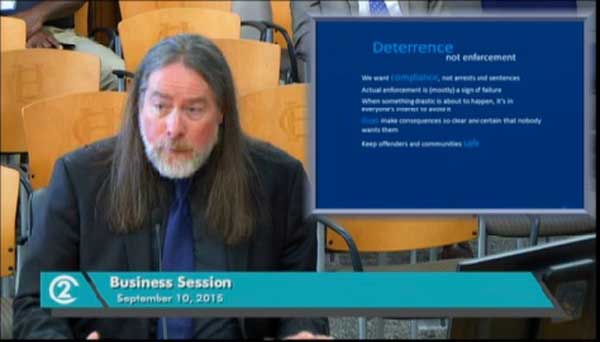 Kansas City is a leading force in a national violence reduction effort that works, an expert told the city council on Thursday.
Kansas City is a leading force in a national violence reduction effort that works, an expert told the city council on Thursday.
Mayor Sly James described Professor David Kennedy as “the godfather, the man so to speak” on the focused deterrence approach used by the Kansas City No Violence Alliance.
He has worked with NoVA and police in other cities on the effort that involves a combination of warnings, help and social services to escape crime and group punishments for the use of violence.
In the second year of NoVA, Kansas City homicides last year dropped to 80 – the lowest number in four decades – down from more than 100 in 2013.
A good start, but expect even better results, said Kennedy, director of the Center for Crime Prevention and Control at John Jay College of Criminal Justice.
For instance, he said, the approach resulted in a 63 percent reduction in youth homicides in Boston, a 42 percent decrease in gun homicides in Stockton, Ca., a 41 percent decline in gang homicides in Cincinnati.
It works but it is not a cure, he said.
Homicides in Kansas City as of Friday morning stand at 65, 12 more than at this time last year.
Kennedy said that is holding steady and far better than huge homicide increases elsewhere.
“Compared to what we’ve seen in a lot of cities this year,” he said, “stable is not bad.”
A lot of the homicide increases this year are not from the group involved networks that focused deterrence programs like NoVA target, he said.
The programs target about .5 percent of people who commit up to 75 percent of violent crimes nationwide, he said, or about 58 percent of violent crimes in Kansas City.
The killers are people who live in fear of being killed, with a murder rate among them of about 3,000 per 100,000 people, he said. Compare that to the national homicide rate of between 4 and 5 persons per 100,000.
“They would be safer serving in Afghanistan than walking in their own neighborhood,” he said.
Not to mention, “the guys themselves are living miserable, frightened and penniless lives,” he said. “Everybody is tired of being tired.”
They are subject to community pressure and offers of help, he said.
One study found that just warning them that police are watching reduced homicides by 26 percent in Boston, he said.
The warnings combine with swift and sure – even modest – action against group members if one uses violence, Kennedy said. In some cities police immediately send people to cut off group members’ illegal electrical and cable links, leaving them wondering in the dark.
Researches have also found that almost none of the homicides are over money, Kennedy said. “Nearly all the violence is about respect and disrespect and girls and standing vendettas and so forth.”
Social media are fueling that by making it much easier to insult and scare people and “keep the beefs going,” he said.
Officials have not helped the situation by flooding high crime neighborhoods with police, Kennedy said, although only a tiny percentage of people there are responsible for serious crime.
Given that large numbers of black males grow up poor, harassed or jailed for minor offenses, Kennedy was asked, why do a very few individuals choose to link up to crime groups and violence?
“We don’t have a clue,” Kennedy said. “We just don’t know – our ability to predict that is next to zero.”



Thank you for this article and it’s multi-year balanced description of violent crime and its decline.